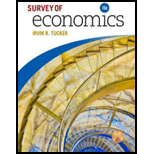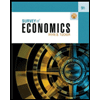
Survey Of Economics
10th Edition
ISBN: 9781337111522
Author: Tucker, Irvin B.
Publisher: Cengage,
expand_more
expand_more
format_list_bulleted
Question
Chapter 2.7, Problem 1GE
To determine
The
Expert Solution & Answer
Want to see the full answer?
Check out a sample textbook solution
Students have asked these similar questions
agrody calming Inted 001 and me
2. A homeowner is concerned about the various air pollutants (e.g., benzene and methane)
released in her house when she cooks with natural gas. She is considering replacing her gas
oven and stove with an electric stove comprising an induction cooktop and convection oven.
The new appliance costs $900 to purchase and install. Capping the old gas line costs an
additional $150 (a one-time fee). The old line must be inspected for leaks each year after
capping, at a cost of $35 for each inspection.
a. If the homeowner plans to remain in the house for four more years and the discount
rate is 4%, what is the minimum present value of the benefits that the homeowner
would need to experience for this purchase to be justified based on its private net
sub present value?
b. While trying to understand how she might express the value of reduced exposure to
indoor air pollutants in dollar terms, the homeowner consulted the EPA website and
found estimates provided by…
After the ban is imposed, Joe’s firm switches to the more expensive biodegradable disposable cups. This increases the cost associated with each cup of coffee it produces.
Which cost curve(s) will be impacted by the use of the more expensive biodegradable disposable cups? Why? Which cost curve(s) will not shift, and why not? Please use the table below to answer this question. For the second column (“Impacted? If so, how?”), please use one of the following three choices: No shift; Shifts up (i.e., increases: at nearly any given quantity, the cost goes up); or Shifts down (i.e., decreases: at nearly any given quantity, the cost goes down). $
Cost Curve
Impacted? If so, how?
Explanation of the Shift: Why or Why Not
AFC
No shift.
Fix costs stay the same, regardless of quantity. Fixed cost is calculated as Fixed Cost/Quantity. Since fixed costs remain unchanged, AFC stays the same for each quantity.
MC
Shifts up.
Since the biodegradable cups are more expensive, the…
Styrofoam is non-biodegradable and is not easily recyclable. Many cities and at least one state have enacted laws that ban the use of polystyrene containers. These locales understand that banning these containers will force many businesses to turn to other more expensive forms of packaging and cups, but argue the ban is environmentally important.
Shane owns a firm with a conventional production function resulting in U-shaped ATC, AVC, and MC curves. Shane's business sells takeout food and drinks that are currently packaged in styrofoam containers and cups.
Graph the short-run AFC0, AVC0, ATC0, and MC0 curves for Shane's firm before the ban on using styrofoam containers.
Chapter 2 Solutions
Survey Of Economics
Ch. 2.6 - Prob. 1YTECh. 2.7 - Prob. 1GECh. 2 - Prob. 1SQPCh. 2 - Prob. 2SQPCh. 2 - Prob. 3SQPCh. 2 - Prob. 4SQPCh. 2 - Prob. 5SQPCh. 2 - Prob. 6SQPCh. 2 - Prob. 7SQPCh. 2 - Prob. 8SQP
Ch. 2 - Prob. 9SQPCh. 2 - Prob. 10SQPCh. 2 - Prob. 11SQPCh. 2 - Prob. 12SQPCh. 2 - Prob. 1SQCh. 2 - Prob. 2SQCh. 2 - Prob. 3SQCh. 2 - Prob. 4SQCh. 2 - Prob. 5SQCh. 2 - Prob. 6SQCh. 2 - Prob. 7SQCh. 2 - Prob. 8SQCh. 2 - Prob. 9SQCh. 2 - Prob. 10SQCh. 2 - Prob. 11SQCh. 2 - Prob. 12SQCh. 2 - Prob. 13SQCh. 2 - Prob. 14SQCh. 2 - Prob. 15SQCh. 2 - Prob. 16SQCh. 2 - Prob. 17SQCh. 2 - Prob. 18SQCh. 2 - Prob. 19SQCh. 2 - Prob. 20SQ
Knowledge Booster
Similar questions
- PART II: Multipart Problems wood or solem of triflussd aidi 1. Assume that a society has a polluting industry comprising two firms, where the industry-level marginal abatement cost curve is given by: MAC = 24 - ()E and the marginal damage function is given by: MDF = 2E. What is the efficient level of emissions? b. What constant per-unit emissions tax could achieve the efficient emissions level? points) c. What is the net benefit to society of moving from the unregulated emissions level to the efficient level? In response to industry complaints about the costs of the tax, a cap-and-trade program is proposed. The marginal abatement cost curves for the two firms are given by: MAC=24-E and MAC2 = 24-2E2. d. How could a cap-and-trade program that achieves the same level of emissions as the tax be designed to reduce the costs of regulation to the two firms?arrow_forwardOnly #4 please, Use a graph please if needed to help provearrow_forwarda-carrow_forward
- For these questions, you must state "true," "false," or "uncertain" and argue your case (roughly 3 to 5 sentences). When appropriate, the use of graphs will make for stronger answers. Credit will depend entirely on the quality of your explanation. 1. If the industry facing regulation for its pollutant emissions has a lot of political capital, direct regulatory intervention will be more viable than an emissions tax to address this market failure. 2. A stated-preference method will provide a measure of the value of Komodo dragons that is more accurate than the value estimated through application of the travel cost model to visitation data for Komodo National Park in Indonesia. 3. A correlation between community demographics and the present location of polluting facilities is sufficient to claim a violation of distributive justice. olsvrc Q 4. When the damages from pollution are uncertain, a price-based mechanism is best equipped to manage the costs of the regulator's imperfect…arrow_forwardFor environmental economics, question number 2 only please-- thank you!arrow_forwardFor these questions, you must state "true," "false," or "uncertain" and argue your case (roughly 3 to 5 sentences). When appropriate, the use of graphs will make for stronger answers. Credit will depend entirely on the quality of your explanation. 1. If the industry facing regulation for its pollutant emissions has a lot of political capital, direct regulatory intervention will be more viable than an emissions tax to address this market failure. cullog iba linevoz ve bubivorearrow_forward
- Exercise 3 The production function of a firm is described by the following equation Q=10,000-3L2 where L stands for the units of labour. a) Draw a graph for this equation. Use the quantity produced in the y-axis, and the units of labour in the x-axis. b) What is the maximum production level? c) How many units of labour are needed at that point? d) Provide one reference with you answer.arrow_forwardExercise 1 Consider the market supply curve which passes through the intercept and from which the market equilibrium data is known, this is, the price and quantity of equilibrium PE=50 and QE=2000. Considering those two points, find the equation of the supply. Draw a graph of this line. Provide one reference with your answer. Exercise 2 Considering the previous supply line, determine if the following demand function corresponds to the market demand equilibrium stated above. QD=3000-2p.arrow_forwardConsider the market supply curve which passes through the intercept and from which the marketequilibrium data is known, this is, the price and quantity of equilibrium PE=50 and QE=2000.a. Considering those two points, find the equation of the supply. b. Draw a graph of this line.arrow_forward
arrow_back_ios
SEE MORE QUESTIONS
arrow_forward_ios
Recommended textbooks for you




 Survey of Economics (MindTap Course List)EconomicsISBN:9781305260948Author:Irvin B. TuckerPublisher:Cengage Learning
Survey of Economics (MindTap Course List)EconomicsISBN:9781305260948Author:Irvin B. TuckerPublisher:Cengage Learning Economics (MindTap Course List)EconomicsISBN:9781337617383Author:Roger A. ArnoldPublisher:Cengage Learning
Economics (MindTap Course List)EconomicsISBN:9781337617383Author:Roger A. ArnoldPublisher:Cengage Learning





Survey of Economics (MindTap Course List)
Economics
ISBN:9781305260948
Author:Irvin B. Tucker
Publisher:Cengage Learning

Economics (MindTap Course List)
Economics
ISBN:9781337617383
Author:Roger A. Arnold
Publisher:Cengage Learning